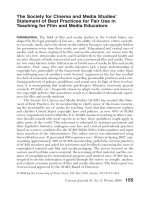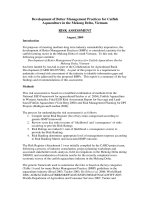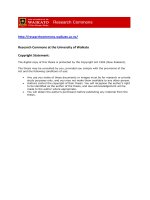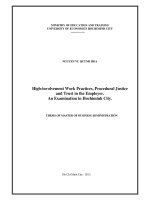BEST PRACTICES FOR NON-BINARY INCLUSION IN THE WORKPLACE AN OUT AMP; EQUAL GUIDE
Bạn đang xem bản rút gọn của tài liệu. Xem và tải ngay bản đầy đủ của tài liệu tại đây (903 KB, 28 trang )
BEST PRACTICES
FOR NON-BINARY
INCLUSION
IN THE
WORKPLACE.
AN OUT & EQUAL GUIDE
Many companies now implement strategies to
ensure policies, benefits, and overall workplace
culture are inclusive of LGBTQ employees.
However, fewer businesses
are familiar with how
to incorporate the full
spectrum of gender diversity,
particularly those with non-
binary gender identities, into
their LGBTQ diversity and
inclusion initiatives.
Non-binary individuals often
experience significant rates1 of
discrimination in the workplace
(almost a third experienced
discrimination in the hiring
process alone.)
A contributing factor in gender-specific policies and
practices combined with a lack of understanding
regarding non-binary identity are significant contributing
factors to the negative experiences faced by non-binary
employees.
For these reasons and many
others, a majority of non-binary
employees remain closeted at
work1 and take great precautions
to avoid further discrimination.
Instances like these highlight the importance of
exercising non-binary inclusion.
The following guide
details a variety of
specific best practices
for creating welcoming
workplace environments
for non-binary
employees.
CONTENTS
4 Gender Identity 101
6 Defining “Non-Binary”
8 Gender-Neutral Language
10 Pronoun Usage
12 Records and Policies
14 Dress Codes
15 Facilities
17 Tips for ERG Engagement
18 Talent Acquisition
22 Practicing Allyship
Gender 101
When approaching the topic of non-binary identity,
it is important to understand the differences
between sex and gender. Typically, the terms “sex”
and “gender” are incorrectly used interchangeably,
though the definitions are quite different.
Sex Gender
A social, The cultural
legal, medical meanings (such
designation as masculinity or
assigned at birth femininity) assigned
based on a medical to biological sexes
assessment of the within a specific
b o d y. historical and
geographic ways of
being.
In today’s society, medical professionals make
designations regarding a newborn’s sex—male,
female, and in some cases, intersex. From those
designations, people make assumptions about a
newborn’s gender identity.
For example, if an individual’s sex was assigned
female at birth (AFAB), people might assume that
the corresponding gender identity would be female.
However, for some, this is not the case.
4
transgender genderqueer
bigender
agender
non-binary
gender fluid gender
non-conforming
People whose gender identity is different
than their sex assigned at birth fall under the
umbrella of transgender identity2.
Some individuals identify with a gender
identity that is opposite of their sex
assigned at birth. Others identify as neither,
both, or somewhere in between female or
male. Many use the word “non-binary” to
describe this identity.
5
Defining “Non-Binary”
Understanding the term “non-binary” is a critical
first step in implementing best practices.
Non-binary: a gender identity which falls outside
of the gender binary, meaning an individual does not
identify as strictly female or male.
A non-binary person can identify as both or
neither male and female, or sometimes one or
the other. There are several other terms used to
describe gender identities outside of the male and
female binary such as genderqueer, gender non-
conforming, agender, and bigender. Though these
terms have slightly different meanings, they refer to
an experience of gender outside of the binary.
While, the term “non-binary” falls under the umbrella
of transgender identity, it is important to note that
identifying as transgender does not mean that particular
individual is non-binary. Though transgender individuals
can be non-binary, most transgender3 individuals
identify as strictly male or female.1
1. Understanding Global Context: Employees may also identify with terms outside of the
typical Western transgender and non-binary discourse. There are a variety of cultures that
recognize third genders. It is important that companies are also inclusive of these (ex:
Indian Hijra, Samoan Fa’afafine, Native American Two-Spirit, etc.) and recognize the
global diversity of gender exceeds Western conceptions of the binary, as well.
6
Many non-binary individuals
use a name different from
their given name, while some
people may undergo surgery to
more closely align their bodies
with their gender identity.
Furthermore, many (but not
all) non-binary individuals use
gender-neutral pronouns.
7
Gender Neutral Language
The use of gender-specific language is common
in everyday life and conversation. Individuals
regularly utilize gendered language when referring
to others, even if the gender does not align with
the subject. For example, the term “man” or terms
ending in “-man4” have been used since the early
development of the English language to refer to
human beings in general (e.i., mankind, “all men are
created equal”).
Y’all Means All!
Greetings that include gender
neutral language such as
“friends, folks, y’all, you all,
and everyone” ensure that you
include all employees when
saying hello or opening a
meeting.
While many use these terms without the intention
to exclude others, gendered language does not
acknowledge or validate the existence of those
who identify outside of the gender binary. Thus, it
is important to rethink common gendered phrases
and adjust by using more inclusive, gender-neutral
language.
8
Utilizing Gender Inclusive
Language
Replace gendered language with gender-inclusive language
wherever possible in every day conversation. When
appropriate, use they/them instead of he/she.
SAY AVOID
“Hello, everyone!” “Ladies and gentlemen”
or “all of you” or “you guys”
“Job responsibilities “His or her job
include...” or “Their responsibilities
job responsibilities include...”
include...” “Employees should
“Employees should approach Human
approach Human Resources with any
Resources with any questions regarding
questions regarding his/her paycheck.”
their paycheck.”
9
Pronouns
Using an individual’s
correct name and pronouns
is an important way to
demonstrate respect and
courtesy towards non-binary
employees in the workplace.
Here are a few ways companies can
demonstrate pronoun inclusivity:
Include pronouns in email signatures.
Introduce pronouns early. When introducing new
employees, include your names and pronouns:
“Hi, I’m Karen! My pronouns are she/
hers. Welcome to the team!”
Know that it’s okay if the employee does not
respond by stating their own pronouns. The
point in including pronouns in introductions is
to create a space for individuals to voluntarily
provide their pronouns.
Practice using gender-neutral pronouns on your
own time. Feeling comfortable with these terms
does not happen immediately and can require
concerted effort.
Be open and willing to being corrected should
you make a mistake when addressing someone.
10
GENDER PRONOUNS
Pronouns Subject Object Possessive Reflexive
He/ He I This is He
Him/ asked told his reminds
His himself
him office
She/ She
Her/ She I This is reminds
Hers asked told her herself
They/ her office They
Them/ remind
Theirs They I This is themself
asked told their
them office
Ze Ze I This is Hir
(or Zie)/ asked told hirs reminds
office hirself
Hir/Hirs hir
Ze Ze I This is Zir
(or Zie)/ asked told zirs reminds
Zir/Zirs office zirself
zir
11
Records and Policies
Non-binary individuals regularly encounter
circumstances which invalidate the very
existence of their gender identity.
For example, an ordinary task, such as filling out
an onboarding document for human resources,
can present challenging experiences for non-
binary employees. If only male and female
options are included in a question regarding
gender, which box do they check?
Companies
should
examine
and update
existing
documents,
policies, and
procedures
to remove
gender-
specific
language
or include
options
beyond male
and female.
12
Records and Policies
Include options beyond male and female on
employee surveys (refer to Out & Equal’s Self-
ID Best Practices for more details regarding the
wording of SOGI data collection questions)
Provide opportunities for employees to
voluntarily list pronouns on onboarding
documentation and nametags
Remove gendered language from policies - For
example, instead of “he/she,” use “they”
If collecting data on prefixes and titles in HR
documentation, include the gender-neutral
option, Mx. (pronounced miks or muks)
If your current benefit and coverage offerings5
do not provide options for listing gender
identities outside of male and female, migrate
to platforms and offerings that do
13
Dress Codes
Company dress codes commonly include gendered
language. Appropriate attire is frequently listed
in categories of male and female, which leaves
non-binary individuals wondering how and where
they fit into the picture. The purpose of company
dress codes is not to enforce gendered attire for
employees, but rather to ensure that they are
dressed in professional and functional wear.
Millennials and Generation Z identify as
non-binary and gender fluid at higher
rates than previous generations.
As more Millennials and
Generation Z - who identify as
non-binary and gender fluid
at higher rates than previous
generations - enter the
workforce, Out & Equal expects
the future of professional dress
to be gender fluid.
Simple changes in a dress code policy6 can ensure
that certain attire is appropriate without using
gendered language. To ensure your company’s dress
code is inclusive of non-binary identity, contact
Out & Equal will
review your company’s current handbook and can
provide recommendations for promoting non-binary
i n c l u s i v i t y.
14
Facilities
Gendered facilities, such as restrooms or locker
rooms, create difficult circumstances for non-binary
employees. Deciding which facility to use—male
or female—forces non-binary individuals to make
decisions about gender identity that don’t reflect
their own internal sense of self. This can also put
them at further risk of experiencing discrimination.
Restrooms ALL-GENDER
RESTROOM
Office management should
determine if there are
opportunities to include
gender-neutral restrooms
in your building.
If companies have single
staff restrooms, consider
converting them to all-
gender facilities.
Utilize the ADA-compliant
signage that doesn’t
reinforce gender binaries,
such as an image of a
toilet in lieu of gendered
pictograms.
The Equal Restroom Access Act, which required all California
businesses to convert single-stall restrooms to all-gender
facilities, provides a useful example of how companies can be
more inclusive of all genders by updating facilities. For more
information on this policy, read Out & Equal’s compliance
brief on California AB 1732.
15
Facilities
Locker Rooms
Depending on the company, employees may need
access to a locker room in order to prepare for the day.
These spaces tend to be separated by gender, and,
again, can present obstacles to non-binary workers who
may be denied access due to appearance.
To alleviate this issue, The University of California
Berkeley implemented an all-gender locker room in
2017. The space provides an area for individuals of
different genders, who might otherwise refrain from
accessing the facility, to change and shower.
16
Tips for ERG Engagement
Employee Resource Groups (ERGs) are key players in
the implementation of LGBTQ equality in the workplace.
ERGs can go a long way to ensure that LGBTQ workplace
equality initiatives elevate and include the voices and
address the needs of non-binary employees, as well.
A recent survey (Fernandez et al.
2017) asked non-binary employees
to prioritize which inclusive practices
were most important to their
experience in the workplace. ERGs
should use these key priorities to
shape their involvement and strategic
engagement on non-binary issues.
Non-Binary Voices - Top Priorities for
Workplace Inclusion6
1 Inclusive dress codes
2 Non-binary genders on records
3 Gender neutral titles
4 No tolerance policies
5 Gender-neutral restrooms
17
Talent Acquisition: Attracting
Millennials and Generation Z
The workforce is ever changing. In order to stay viable
and attract talent, businesses must ensure company
values attract that of the incoming workforce.
In the year 2025, Millennials,
the most diverse generation
so far, will represent 75% of
the workforce8. Millennials
are more than two times
as likely to identify as
LGBTQ and more likely to
identify as non-binary or
gender fluid than previous
generations9.
18
Talent Acquisition: Attracting
Millennials and Generation Z
When looking for a job, 88% of Millennials
seek work-life integration10, or, in other
words, “blending their personal and
professional lives, in order to make both
work better.” A powerful signal of that factor
is LGBTQ inclusion.
Values guide where Millennials work7,
as 56 percent of Millennials have “ruled out
ever working for a particular organization
because of its values or standard of
conduct.” 19









